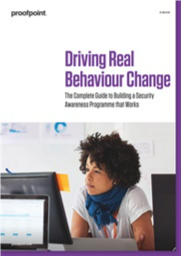Driving Real Behaviour Change
Today's most potent cyber threat isn't a zero-day vulnerability, new malware or the latest exploit kit. It's your own users. That's because today's attacks target people, not IT infrastructure. No matter what form they take, most cyber attacks need a human victim to help activate them. They trick people into opening malicious attachments, clicking unsafe URLs, handing over account credentials and even taking direct action— such as wiring money or sending sensitive data.
This guide shows you how to create and sustain an efficient and effective cybersecurity education programme—regardless of your programme maturity, vendor or obstacles you may face. It provides key facts, effective strategies, valuable resources and practical tips for security leaders at every stage of the security awareness journey.
Read More
By submitting this form you agree to Proofpoint contacting you with marketing-related emails or by telephone. You may unsubscribe at any time. Proofpoint web sites and communications are subject to their Privacy Notice.
By requesting this resource you agree to our terms of use. All data is protected by our Privacy Notice. If you have any further questions please email dataprotection@techpublishhub.com
Related Categories: AIM, Cloud, Compliance, Email, Email Security, IT Security, Malware, Mobile Security, NAS, Network, SAN, Software, Spam, Wi-Fi


More resources from Proofpoint

Research Report: ESG Analyses the Economic Be...
Did you know the average annual cost for insider threats is now $11.45M, according to Ponemon Institute? It's a growing problem as remote teams bec...

How Proofpoint Defends Against Cloud Account ...
Prevent and mitigate potentially devastating cloud account takeovers. Cyber criminals are following businesses into the cloud. As more companies ad...

You've Got Email Fraud! A Roundup of the 10 B...
Business email compromise (BEC) fraud affects organisations of all sizes across every industry around the world, exposing them to billions of dolla...